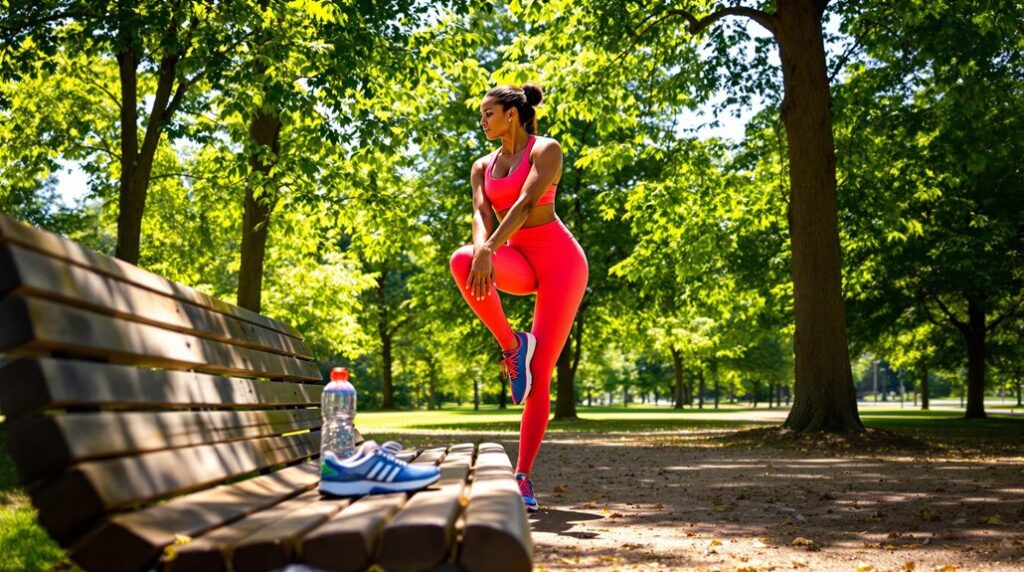To alleviate runner's knee, incorporate specific stretches into your routine. Focus on the IT band, glutes, quadriceps, and hamstrings. Simple stretches include crossing your legs to stretch the IT band, lying on your back to stretch the glutes, bending your knee to stretch the quadriceps while lying face down, and elevating a foot on a chair to stretch the hamstrings. Regularly performing these stretches can enhance flexibility and reduce knee strain. There's more valuable information on maintaining knee health to uncover.
Understanding Runner's Knee
Understanding runner's knee is essential for anyone who regularly participates in running or similar activities, especially since this condition can greatly impact your performance and overall enjoyment. Runner's knee, often marked by pain on the outer part of your knee, typically arises from irritations caused by the iliotibial (IT) band during repetitive motions. Many confuse it with patellofemoral pain syndrome, which affects the front of the knee. This condition is frequently linked to overuse and excessive knee flexion, especially when running at a repetitive angle of around 21 degrees. Symptoms may intensify with increased running intensity or duration, leading to inflammation. Effective management through targeted exercises can alleviate pain, improve flexibility, and reduce the risk of future injuries.
Importance of Stretching for Runners
While running offers numerous physical benefits, neglecting to incorporate stretching into your routine can lead to increased risk of injury, particularly conditions like runner's knee. Stretching improves flexibility, enhancing your range of motion and overall performance. By regularly stretching, you reduce muscle tension, which minimizes the risk of injuries caused by tight muscles and tendons. Increased blood flow to your muscles from stretching aids recovery and reduces soreness post-run. Specifically targeting the IT band, quadriceps, hamstrings, and glutes can alleviate pressure on the knee joint, helping to prevent runner's knee symptoms. Additionally, stretching promotes better body alignment, which is essential for maintaining proper biomechanics and reducing the likelihood of knee pain during your runs.
Key Stretches for Runner's Knee
Incorporating key stretches into your routine is essential for preventing runner's knee and enhancing overall performance. Start with the ITB stretch by crossing your legs while standing, running an arm down the side of the opposite leg for 30 seconds to relieve tension. Next, perform a glute stretch by lying on your back, bringing one knee towards the opposite shoulder, and adjusting the angle for 30 seconds. For the quad stretch, lie face down, bend your knee, and bring your heel towards your bottom, using a towel or hand for added pressure for a 30-second hold. Finally, standing with a foot on a chair for a hamstring stretch helps improve flexibility and reduce knee strain.
Additional Exercises to Support Knee Health
To maintain ideal knee health, you should consider integrating a variety of additional exercises into your routine that specifically target the muscles surrounding the knee joint. Regularly incorporating stretches like the ITB and hamstring stretches can enhance flexibility and reduce tension in the knee area, which aids in preventing runner's knee. Additionally, the glute stretch alleviates hip tightness, emphasizing the connection between hip and knee health. Strengthening hip abductors through clam shell exercises supports proper knee alignment during running, reducing lateral knee pain risk. Finally, targeted quadriceps stretches improve knee mobility and relieve pressure on the joint. Engaging in these exercises not only assists in rehabilitation but also serves as a proactive strategy to maintain knee health and prevent injuries.
When to Seek Professional Help
Maintaining a routine of stretching and strengthening exercises can greatly contribute to knee health, but recognizing when to seek professional help is equally important. If you're experiencing persistent knee pain during or after running that lasts more than a few days, it's advisable to consult a professional. Additionally, if you notice swelling, instability, or a feeling of weakness in your knee joint, a physiotherapist can provide valuable insight. If your self-administered stretches and exercises don't alleviate pain, guidance may be necessary for effective rehabilitation. Seek help if pain worsens with activity or limits daily tasks, as this indicates a potential underlying issue. A professional assessment can create a tailored exercise plan addressing specific weaknesses and imbalances contributing to runner's knee.


